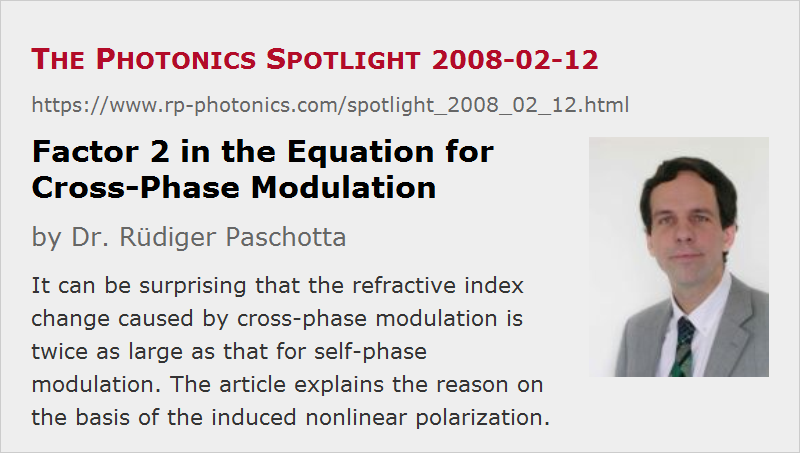Factor 2 in the Equation for Cross-Phase Modulation
Posted on 2008-02-12 as a part of the Photonics Spotlight (available as e-mail newsletter!)
Permanent link: https://www.rp-photonics.com/spotlight_2008_02_12.html
Author: Dr. Rüdiger Paschotta, RP Photonics Consulting GmbH
Abstract: It can be surprising that the refractive index change caused by cross-phase modulation is twice as large as that for self-phase modulation. The article explains the reason on the basis of the induced nonlinear polarization.

Ref.: encyclopedia articles on cross-phase modulation, self-phase modulation, and nonlinear polarization
Cross-phase modulation is often described with the equation
for the change of the refractive index for a beam 2, as caused by an intense beam 1. It is assumed that both beams are linearly polarized in the same direction. The factor 2, which does not occur in the corresponding equation for self-phase modulation, should be rather surprising: how can the refractive index change for beam 2 be twice as large as that for beam 1 itself, even though the wavelengths of both beams can be very similar? Apparently it is not the wavelength making the difference, but what else?
The answer is obtained with a closer inspection of the physics behind cross-phase modulation and self-phase modulation. Both effects are caused by the nonlinear polarization in the medium as is related to the χ(3) tensor. Locally, this polarization is proportional to χ(3) (E1 exp(+i ω1) + E1 exp(-i ω1) + E2 exp(+i ω2) + E2 exp(-i ω2))3. This nonlinear polarization is responsible for a variety of effects. We have to expand the above equation, which leads to 43 = 64 terms. Now consider the two above mentioned nonlinear effects:
- We first look out for the terms describing self-phase modulation for beam 1. This must be related to components with a time dependence exp(±i ω1), which can only result from such combinations of factors with ±ω1, where both signs occur: one sign twice, the other one just once. There are 6 terms of that kind.
- Next we look at terms for cross-phase modulation, where beam 1 influences beam 2. Such terms need to contain ±ω2, but also two terms with ±ω1 which cancel each other via different signs. There are 12 of those – twice as many as for self-phase modulation. And this is the reason for the ominous factor of 2: the nonlinear polarization gets twice as large, compared with a situation where beam 2 influences itself.
We see that although the nonlinear index n2 provides a convenient description of such nonlinear effects, in a way it hides the physics, and we should still be aware of the nonlinear polarization.
This article is a posting of the Photonics Spotlight, authored by Dr. Rüdiger Paschotta. You may link to this page and cite it, because its location is permanent. See also the RP Photonics Encyclopedia.
Note that you can also receive the articles in the form of a newsletter or with an RSS feed.
Questions and Comments from Users
Here you can submit questions and comments. As far as they get accepted by the author, they will appear above this paragraph together with the author’s answer. The author will decide on acceptance based on certain criteria. Essentially, the issue must be of sufficiently broad interest.
Please do not enter personal data here; we would otherwise delete it soon. (See also our privacy declaration.) If you wish to receive personal feedback or consultancy from the author, please contact him e.g. via e-mail.
By submitting the information, you give your consent to the potential publication of your inputs on our website according to our rules. (If you later retract your consent, we will delete those inputs.) As your inputs are first reviewed by the author, they may be published with some delay.
 |





If you like this page, please share the link with your friends and colleagues, e.g. via social media:
These sharing buttons are implemented in a privacy-friendly way!